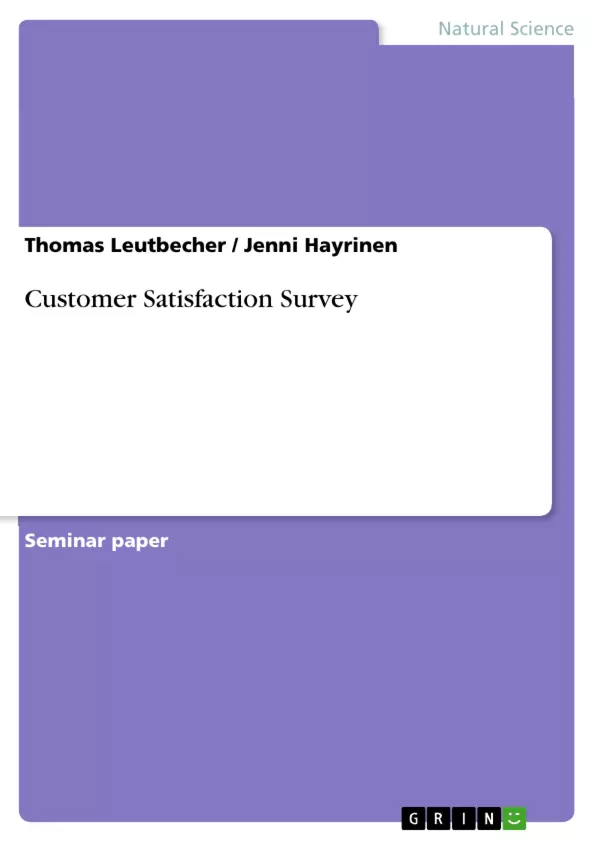This paper will tell about the customer satisfaction in a café downtown Helsinki. The reason why we chose this particular research, started out with personal experience, or better the wish for improvement. Since we are interested in marketing we started approaching our own wishes in a marketer’s way, long before we were instructed to conduct this project. So we asked ourselves how we would do it better. But to get anywhere close to an answer, one needs to know about what other customers think, with what they might agree or disagree. So our second question was: how do people see it?
Now, as we were assigned to this project, it seemed rather interesting to find out, if our own wishes first of all would be of significance compared to other customers. And secondly, to learn about how simple or difficult it would be for an owner or marketer of such an establishment, to find out about the needs for improvement from the customers point of view.
The problem setting of this customer satisfaction survey is divided in four parts: The management needs to know whether the personnel are considered customer-service oriented. Further, how customers think about the place itself, the pricing and the products offered.
The background of this work is the idea of how to obtain or improve a market position. In order to do so, it is vital to know about the market itself and the customers and their wishes. In this particular field, everything stands and falls with customer satisfaction. Therefore it is desirable to gain knowledge about the customers and their point of view. Although this is only a part of the marketing mix, which has to be considered for a healthy business, next to the knowledge about competition, in this field it might be the most important one.
Table of Contents
- INTRODUCTION
- THEORETICAL BACKGROUND
- RESEARCH DESIGN PROCESS
- VALIDITY AND RELIABILITY OF THE SURVEY
- ANALYSIS OF THE RESULTS
- ANALYZING METHODS
- BACKGROUND VARIABLES
- MEANS OF THE LIKERT SCALE VARIABLES
- CROSSTABULATION
- STRENGTH OF THE RELATIONSHIP
- CONCLUSIONS AND RECOMMENDATIONS
- RECOMMENDATIONS BASED ON DATA
- CONCLUSION ON CONDUCTION
- APPENDIXES
Objectives and Key Themes
This project work focuses on a customer satisfaction survey conducted in a café in Helsinki, aiming to identify weaknesses from a customer perspective and provide recommendations for improving the café's performance. The survey focuses on understanding customer perceptions of the café's personnel, environment, pricing, and products.
- Customer satisfaction and its importance in the restaurant business
- Analyzing customer perceptions of various aspects of the café, including personnel, environment, pricing, and products
- Identifying areas for improvement in the café to maximize customer satisfaction
- The use of survey research to gain insights into customer needs and expectations
- The application of marketing principles to understand and improve customer satisfaction in a service-oriented market.
Chapter Summaries
- Introduction: This chapter introduces the customer satisfaction survey conducted in a café in downtown Helsinki. It outlines the objectives of the study, highlighting the need to understand customer perceptions to improve the café's performance. The chapter discusses the motivation behind the research, emphasizing the importance of customer satisfaction in the restaurant business.
- Theoretical Background: This chapter delves into the theoretical framework underpinning the research. It defines key concepts such as population, sampling unit, and sample, and explores the role of market research in understanding customer needs. The chapter emphasizes the importance of customer satisfaction in service-oriented industries like the restaurant business, particularly in relation to the marketing mix and customer-delivered value.
- Research Design Process: This chapter describes the research methodology employed in the study. It outlines the sampling process, including the population, sampling unit, sampling method, and sample size. The chapter details the design of the questionnaire, highlighting the use of Likert scales and demographic information collected. It also discusses the survey administration process and the measures taken to ensure data quality.
- Validity and Reliability of the Survey: This chapter examines the validity and reliability of the survey, acknowledging the limitations of using a sample to represent the entire population. It discusses the potential impact of the sample size and the use of a questionnaire on the reliability of the findings.
Keywords
Customer satisfaction, restaurant business, marketing mix, customer-delivered value, survey research, Likert scale, sampling, data analysis, recommendations for improvement.
- Quote paper
- Thomas Leutbecher (Author), Jenni Hayrinen (Author), 2002, Customer Satisfaction Survey, Munich, GRIN Verlag, https://www.hausarbeiten.de/document/4573


